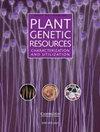一种新的耐盐棉花亲本选择策略
IF 0.7
4区 生物学
Q3 PLANT SCIENCES
Plant Genetic Resources: Characterization and Utilization
Pub Date : 2023-04-11
DOI:10.1017/s1479262123000217
引用次数: 0
摘要
盐碱化是棉花增产的主要障碍。为探索盐胁迫条件下产量较高的遗传物质,采用系×系杂交设计,对8个亲本(5个母本和3个雄性亲本)进行杂交。杂交成功后,在对照和NaCl胁迫(10和20 dSm−1)条件下,对亲本及其15个杂交组合的籽棉产量、铃产量组成、纤维品质、离子和生化性状进行了评价。盐胁迫条件下,各基因型籽棉产量、纤维长度和纤维强度均降低,皮棉率和纤维细度均增加。在盐胁迫条件下,亲本RH-647和杂种FH-214 × FH-2015籽棉产量表现较好,亲本KEHKSHAN和杂种FH-214 × KEHKSHAN的纤维品质性状表现较好。结果表明,株高、铃重、衣分、纤维长度和纤维强度是今后棉花选育中耐盐基因型的可靠性状。本文章由计算机程序翻译,如有差异,请以英文原文为准。
A novel parent selection strategy for the development of salt-tolerant cotton cultivars
Salinity poses a major obstacle in increasing the yield of cotton. To explore genetic material that can yield better under salt stress conditions, eight parents including 5 females and 3 testers were crossed in line × tester mating design. After successful completion of crossing, parents and their 15 crosses were evaluated for seed cotton yield, within boll yield components, fibre quality, ionic and biochemical traits under control and NaCl salt stressed conditions (10 and 20 dSm−1). Under salt stress conditions seed cotton yield, fibre length and fibre strength decreased in all genotypes whereas, lint percentage and fibre fineness increased. Among parents RH-647 and among crosses FH-214 × FH-2015 performed better for seed cotton yield while for fibre quality traits under salt stress conditions among parents KEHKSHAN, and among crosses FH-214 × KEHKSHAN performed better. Results suggested that plant height, boll weight, lint percentage, fibre length and fibre strength are reliable traits for the selection of salt tolerant genotypes in the future cotton breeding programs.
求助全文
通过发布文献求助,成功后即可免费获取论文全文。
去求助
来源期刊

Plant Genetic Resources: Characterization and Utilization
Agricultural and Biological Sciences-Agronomy and Crop Science
CiteScore
2.80
自引率
0.00%
发文量
29
审稿时长
>12 weeks
期刊介绍:
Plant Genetic Resources is an international journal which provides a forum for describing the application of novel genomic technologies, as well as their integration with established techniques, towards the understanding of the genetic variation captured in both in situ and ex situ collections of crop and non-crop plants; and for the airing of wider issues relevant to plant germplasm conservation and utilisation. We particularly welcome multi-disciplinary approaches that incorporate both a technical and a socio-economic focus. Technical aspects can cover developments in technologies of potential or demonstrated relevance to the analysis of variation and diversity at the phenotypic and genotypic levels.
 求助内容:
求助内容: 应助结果提醒方式:
应助结果提醒方式:


